-
ARTÍCULO ORIGINAL08/12/2024
Initial nipple damages in breastfeeding women: analysis of photographic images and clinical associations
Revista Brasileira de Enfermagem. 2024;77(1):e20220773
Resumen
ARTÍCULO ORIGINALInitial nipple damages in breastfeeding women: analysis of photographic images and clinical associations
Revista Brasileira de Enfermagem. 2024;77(1):e20220773
DOI 10.1590/0034-7167-2022-0773
Visualizações0Ver maisABSTRACT
Objective:
to analyze the initial nipple damage degree by breastfeeding practice and to associate findings with clinical manifestations of breastfeeding women.
Methods:
a retrospective, cross-sectional study with primary data and photographic images database from two randomized clinical trials. Photographic images were analyzed by two independent evaluators using the Nipple Trauma Score. For analysis, the chi-square, Mann-Whitney tests and Kappa coefficient were applied.
Results:
115 breastfeeding women and their respective 186 photographic images were analyzed. The degree of agreement of evaluators using the Nipple Trauma Score was 93.6%. The nipple pain score during breastfeeding was moderate and compromised more than 25% of the nipple surface area.
Conclusions:
assistance to breastfeeding women should prioritize nipple pain intensity instead of the nipple damage size.
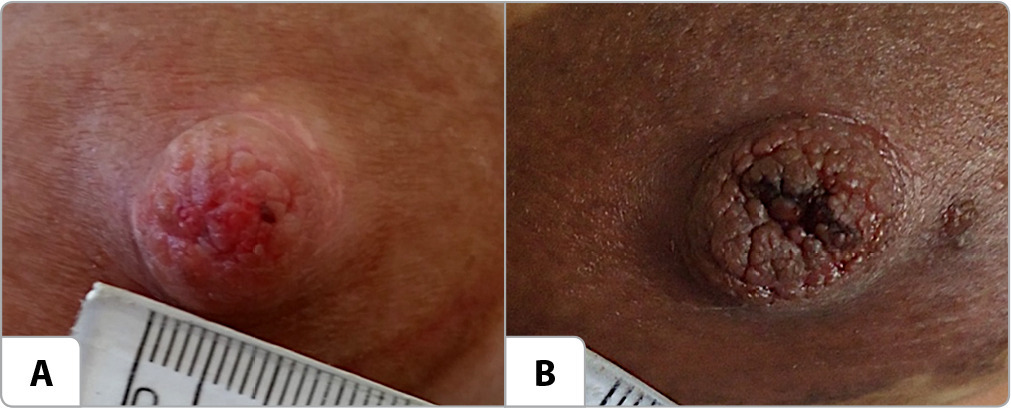
-
ARTÍCULO ORIGINAL08/12/2024
Safe practices for bed bathing in the intensive care unit: validation of a checklist
Revista Brasileira de Enfermagem. 2024;77(1):e20230135
Resumen
ARTÍCULO ORIGINALSafe practices for bed bathing in the intensive care unit: validation of a checklist
Revista Brasileira de Enfermagem. 2024;77(1):e20230135
DOI 10.1590/0034-7167-2023-0135
Visualizações0Ver maisABSTRACT
Objective:
To validate a checklist for safe bathing in critically ill patients.
Methods:
This is a methodological and quantitative study. Researchers developed a checklist for safe bathing in critically ill patients consisting of 41 items, which were submitted to the apparent and content validation process, evaluated by eleven judges, and interobserver reliability. For reliability analysis, the instrument was applied in 54 bed bath procedures in the ICU; Kappa and CHF tests were used.
Results:
In the apparent and content validation, adjustments were made according to the judges’ suggestions. Kappa values ranged from moderate to almost perfect (0.462 to 0.962), and, in some items, there was 100% agreement; the reliability of the instrument was excellent (ICC = 0.962).
Conclusion:
The instrument proved to be dependable and easy to apply. Its use will contribute to safe bed bathing and subsidize interventions aimed at increasing the quality of care.
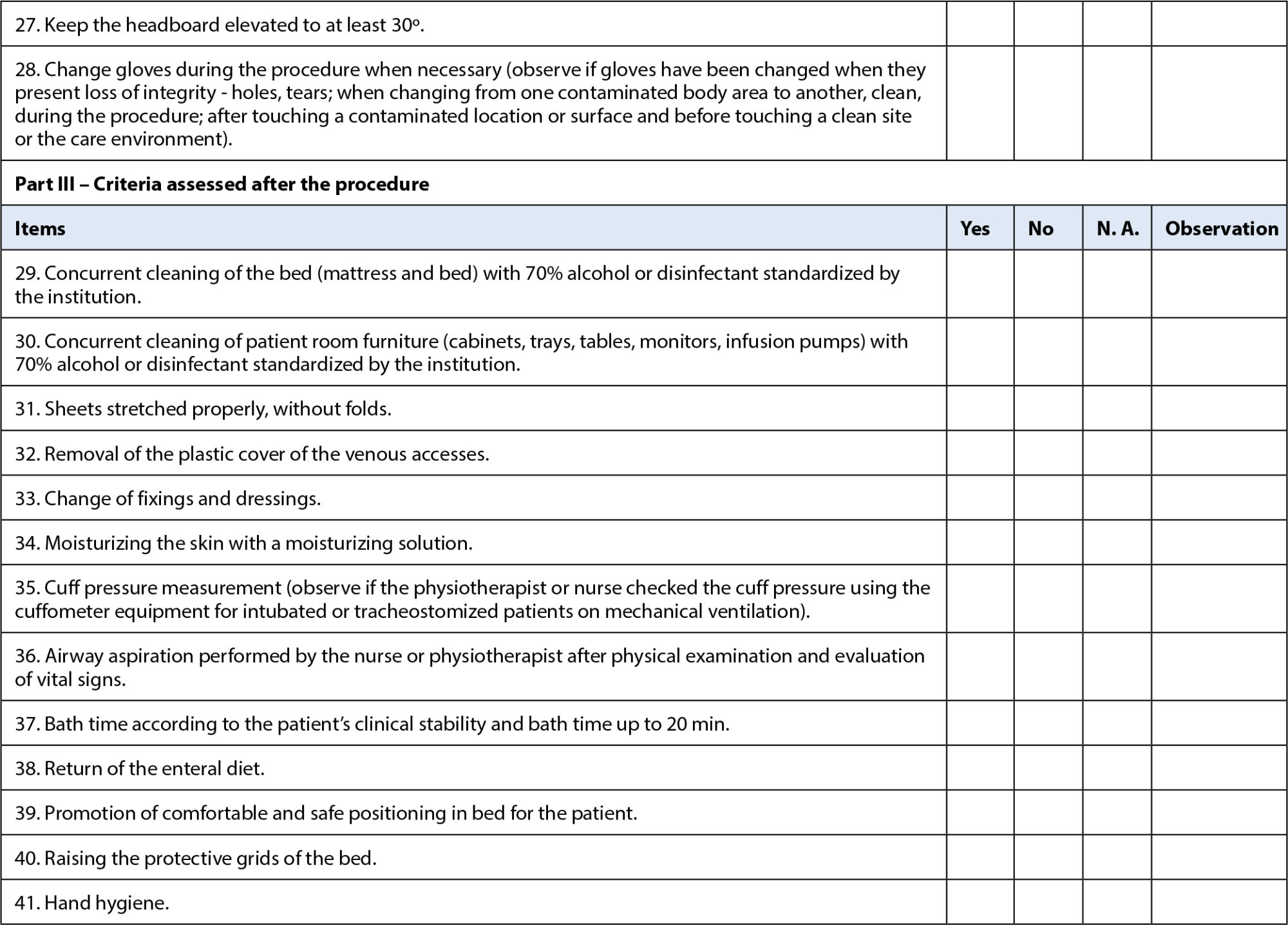
-
ARTÍCULO DE REVISIÓN29/11/2024
Assessment of knowledge in oncology about care for transgender people: a scoping review
Revista Brasileira de Enfermagem. 2024;77:e20230532
Resumen
ARTÍCULO DE REVISIÓNAssessment of knowledge in oncology about care for transgender people: a scoping review
Revista Brasileira de Enfermagem. 2024;77:e20230532
DOI 10.1590/0034-7167-2023-0532
Visualizações0Ver maisABSTRACT
Objective:
to identify evidence available in the literature on instruments and methodologies used to assess healthcare professionals’ knowledge about cancer care for the transgender population.
Methods:
a scoping review was conducted in seven databases, including studies that answered the question: what is the healthcare professionals’ level of knowledge about cancer care for the transgender population?
Results:
forty-one articles were selected that dealt specifically with healthcare professionals’knowledge in relation to care for the LGBTQIAPN+ population, especially the transgender population. Eighteen studies assessed patients’ perceptions of professionals’knowledge, whereas other studies used their own assessment tools, considering the global context of LGBTQIAPN+ health.
Conclusions:
there is no tested and validated instrument that assesses the knowledge about the transgender population’s oncological health, highlighting the need to construct and validate an instrument focused on this population’s needs.
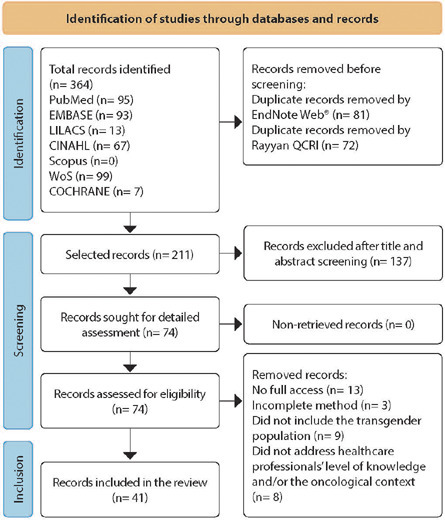
-
ARTÍCULO ORIGINAL29/11/2024
Sleep quality of vulnerable elderly people: associated factors
Revista Brasileira de Enfermagem. 2024;77:e20230283
Resumen
ARTÍCULO ORIGINALSleep quality of vulnerable elderly people: associated factors
Revista Brasileira de Enfermagem. 2024;77:e20230283
DOI 10.1590/0034-7167-2023-0283
Visualizações0Ver maisABSTRACT
Objective:
To identify factors associated with poor sleep quality in elderly dependent individuals in social vulnerability.
Method:
Cross-sectional study with 59 elderly dependent individuals assisted by Family Health Units in São Carlos/SP. The following tools were used: Katz Index, Lawton and Brody Scale, Pittsburgh Sleep Quality Index, Addenbrooke’s Cognitive Examination Revised, Fried’s Frailty Phenotype, Geriatric Depression Scale (15 items), Perceived Stress Scale, Family APGAR, Social Support Scale from the Medical Outcomes Study, and World Health Organization Quality of Life, abbreviated and “old” versions.
Results:
The majority of participants were women (52.5%), aged 60-74 years (71.1%), and had poor sleep quality (76.2%). Stress (OR=1.12; 95%CI=1.02-1.22) and polypharmacy (OR=7.39; 95%CI=1.22-44.73) increased the chances of poor sleep quality, while physical activity decreased these chances (OR=0.15; 95%CI=0.02-0.79).
Conclusion:
Stress and polypharmacy are associated with poor sleep quality in elderly dependent individuals.
-
ARTÍCULO DE REVISIÓN22/11/2024
Transition to family parenting in the face of the first child: a scoping review
Revista Brasileira de Enfermagem. 2024;77(5):e20230487
Resumen
ARTÍCULO DE REVISIÓNTransition to family parenting in the face of the first child: a scoping review
Revista Brasileira de Enfermagem. 2024;77(5):e20230487
DOI 10.1590/0034-7167-2023-0487
Visualizações1Ver maisABSTRACT
Objectives:
to identify and summarize the elements that characterize the family transition process in relation to the first child.
Methods:
a scoping review was carried out based on JBI methodology, in six databases, following the Preferred Reporting Items for Systematic reviews and Meta-Analyses extension for Scoping Reviews checklist.
Results:
ten articles were included with factors characterizing the transition, such as hindering/facilitating conditions that influence the process, important support structures in adaptation and strategies/responses used in the transition process.
Final Considerations:
elements characterizing the transition process in relation to the first child were identified. However, no theoretical explanation for this was identified. Further research should be carried out to obtain a deeper understanding of this process.
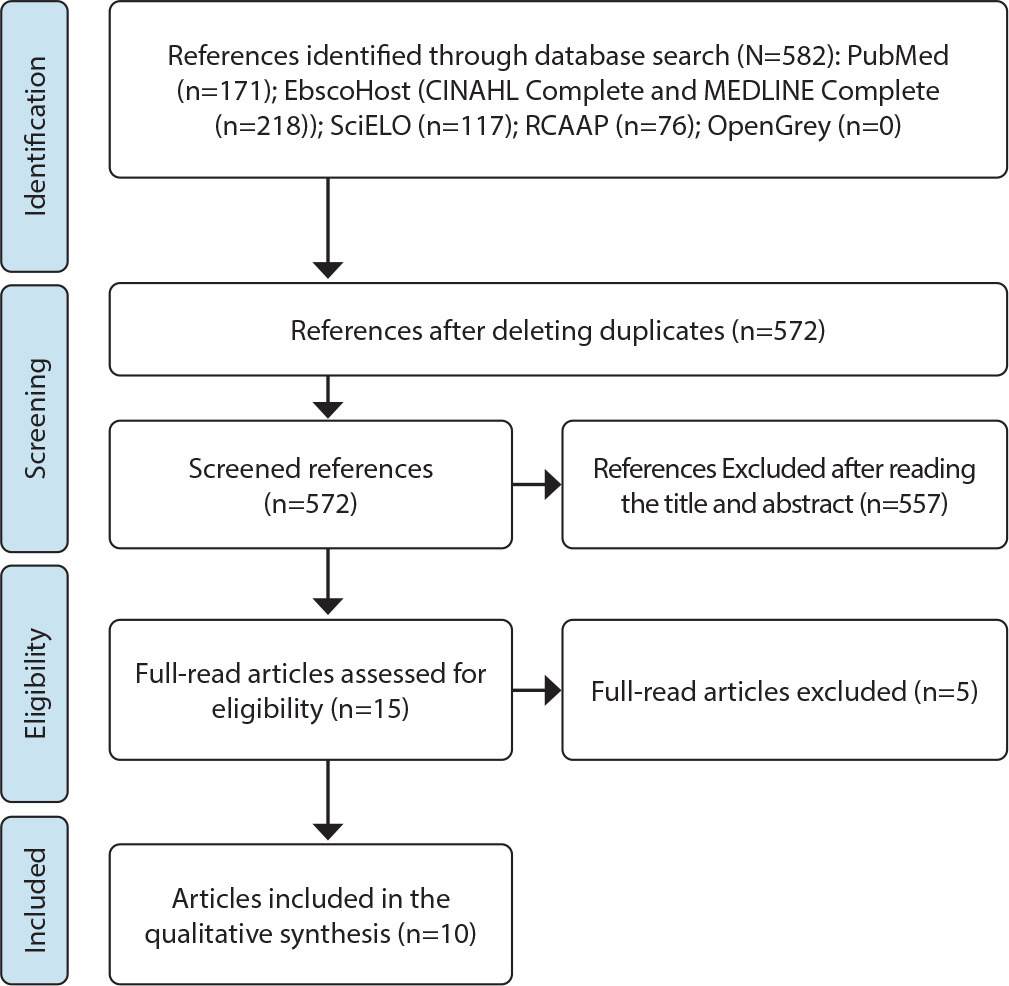
-
22/11/2024
Social Technology in the Prevention of Adolescent Violence: documentary production
Revista Brasileira de Enfermagem. 2024;77(5):e20230298
Resumen
Social Technology in the Prevention of Adolescent Violence: documentary production
Revista Brasileira de Enfermagem. 2024;77(5):e20230298
DOI 10.1590/0034-7167-2023-0298
Visualizações0Ver maisABSTRACT
Objective:
To report the development of a technological innovation in the form of a documentary, aimed at disseminating actions for preventing violence against adolescents within the context of Primary Health Care.
Methods:
The documentary was developed through action research and interventions with adolescents in the territory of a Health Unit, conducted between 2020 and 2022, using Social Technology as both an action strategy and a conceptual reference.
Results:
The Social Technology proposal, created through workshops and seminars, resulted in a documentary focusing on violence prevention, involving 48 adolescents. The documentary’s script, collectively developed, portrays a soccer match between teams symbolizing peace and violence, with peace ultimately prevailing. The documentary is six minutes long.
Final Considerations:
The documentary has proven to be an effective Social Technology tool among adolescents, as it fosters critical thinking, is accessible, has potential for digital dissemination, and appeals to the target audience.
-
ARTÍCULO ORIGINAL22/11/2024
Prevalence of prescription and effectiveness of analgesia for treating vaginal delivery pain
Revista Brasileira de Enfermagem. 2024;77(5):e20230327
Resumen
ARTÍCULO ORIGINALPrevalence of prescription and effectiveness of analgesia for treating vaginal delivery pain
Revista Brasileira de Enfermagem. 2024;77(5):e20230327
DOI 10.1590/0034-7167-2023-0327
Visualizações0Ver maisABSTRACT
Objectives:
to assess pain management during labor.
Methods:
a cross-sectional study was carried out by reviewing medical records and conducting postpartum interviews. Prevalence and effectiveness of analgesia were assessed.
Results:
the prevalence of non-pharmacological analgesia was 61.86% of 215 women in labor in Obstetric Center and 82.51% of 62 in midwife-led unit. Prevalence of severe pain, on the Visual Analogue Scale, before and after non-pharmacological analgesia, was from 92.16% to 64.04% (p=0.00) in Obstetric Center and from 85.96% to 52.63% (p=0.01) in midwife-led unit. Prevalence of pharmacological analgesia in Obstetric Centers was 15.81%, with no variation in severe pain (p=0.57). Patients’ request for analgesia was associated with education (p=0.00) and pain intensity (p=0.02).
Conclusions:
non-pharmacological analgesia improved pain intensity. Prevalence of pharmacological analgesic prescription was lower than that identified in developed countries. Pain management needs to consider the preferences and needs of women in labor.
-
REFLEXIÓN15/02/2021
Pre-hospital assistance by ambulance in the context of coronavirus infections
Revista Brasileira de Enfermagem. 2021;74:e20200657
Resumen
REFLEXIÓNPre-hospital assistance by ambulance in the context of coronavirus infections
Revista Brasileira de Enfermagem. 2021;74:e20200657
DOI 10.1590/0034-7167-2020-0657
Visualizações0Ver maisABSTRACT
Objective:
To reflect on the safe care exercised by the pre-hospital care team by emergency ambulance in times of coronavirus infection.
Method:
A reflection and description of how to provide safe care to the patient and the professional during pre-hospital care in times of coronavirus infection.
Results:
To ensure the health of all those involved in the care, health professionals who work in pre-hospital care by emergency ambulance should use the recommended Personal Protective Equipment (PPE), such as the use of surgical masks and N95, N99, N100, PFF2 or PFF3, the use of an apron or overall, goggles and face shield, gloves and a hat. The entire team must receive training and demonstrate the ability to use PPE correctly and safely.
Final considerations:
The professional working in the pre-hospital care by ambulance is exposed to a series of occupational risks that need to be discussed and minimized through professional training.
-
ARTÍCULO ORIGINAL17/02/2020
Análise dos registros de técnicos de enfermagem e enfermeiros em prontuários
Revista Brasileira de Enfermagem. 2020;73(2):e20180542
Resumen
ARTÍCULO ORIGINALAnálise dos registros de técnicos de enfermagem e enfermeiros em prontuários
Revista Brasileira de Enfermagem. 2020;73(2):e20180542
DOI 10.1590/0034-7167-2018-0542
Visualizações0RESUMO
Objetivos:
analisar as principais não conformidades dos registros de enfermagem de um hospital público do Nordeste na cidade de Natal.
Métodos:
estudo descritivo, transversal, abordagem quantitativa. Realizado em enfermarias médicas e cirúrgicas. Amostra composta de 120 prontuários de pacientes internados entre outubro e dezembro de 2016. Os dados obtidos foram tabulados e analisados por estatística simples em frequência absoluta e relativa com o software Microsoft Excel 2013. Para avaliar as não conformidades dos registros, usou-se o Diagrama de Pareto.
Resultados:
como principais problemas nos registros de enfermagem, destacou-se a ausência da categoria profissional e número do conselho, responsáveis por 41,8% das não conformidades nos registros de técnicos de enfermagem, enquanto nas anotações dos enfermeiros foram a ausência de hora e as letras ilegíveis, com 61,2%.
Conclusões:
o estudo evidenciou que os profissionais de enfermagem realizam seus registros de forma incompleta e que muitas vezes não documentam o cuidado prestado.
Palavras-chave: ComunicaçãoEnfermagemPesquisa sobre Serviços de SaúdeRegistros de EnfermagemSegurança do PacienteVer mais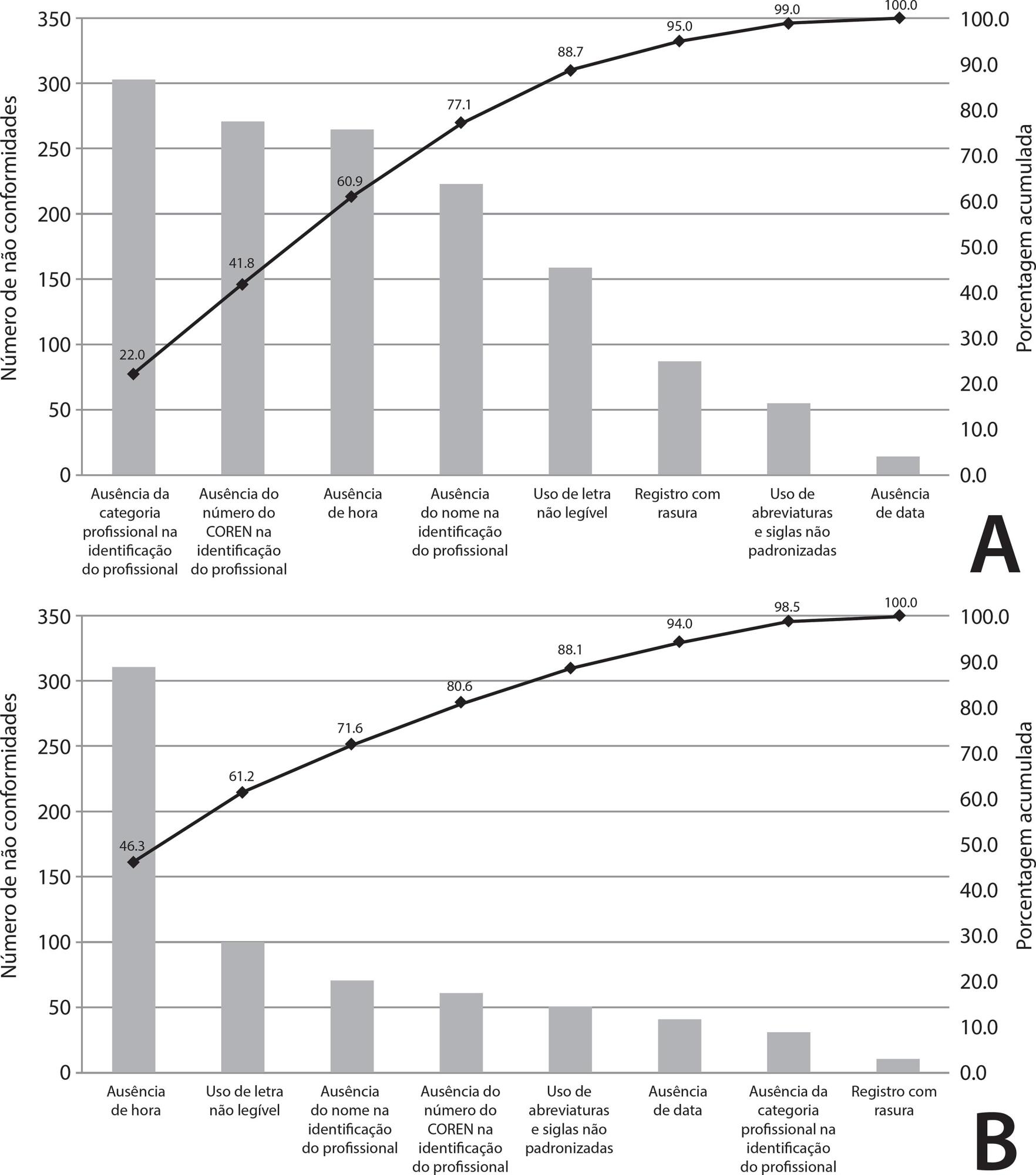
-
ARTÍCULO ORIGINAL21/09/2020
Prevalence of xerostomia in women during breast cancer chemotherapy
Revista Brasileira de Enfermagem. 2020;73:e20190785
Resumen
ARTÍCULO ORIGINALPrevalence of xerostomia in women during breast cancer chemotherapy
Revista Brasileira de Enfermagem. 2020;73:e20190785
DOI 10.1590/0034-7167-2019-0785
Visualizações0Ver maisABSTRACT
Objective:
To identify the prevalence of xerostomia in women undergoing chemotherapy for breast cancer.
Method:
Prospective cohort with 27 women who underwent up to 16 sessions of intravenous chemotherapy. Data collection was performed at the outpatient clinic of a university hospital in the city of São Paulo, where two forms were applied before the start of treatment and the Xerostomia Inventory before and after each chemotherapy session.
Results:
Complaints of dry mouth were present in 48.1% of women before chemotherapy, and they were approximately 28 times more likely to develop dry mouth during treatment. It was observed that the use of antiemetics contributed to the occurrence of xerostomia, and the anti-ulcerous were presented as a protective factor.
Conclusion:
The study identified both a high prevalence of xerostomia regardless of the chemotherapy used and the need to create protocols to improve the quality of life of these patients.
-
ARTÍCULO ORIGINAL19/10/2020
Necessidade de conforto percepcionada por idosos hospitalizados: uma análise à luz da teoria de Kolcaba
Revista Brasileira de Enfermagem. 2020;73:e20190501
Resumen
ARTÍCULO ORIGINALNecessidade de conforto percepcionada por idosos hospitalizados: uma análise à luz da teoria de Kolcaba
Revista Brasileira de Enfermagem. 2020;73:e20190501
DOI 10.1590/0034-7167-2019-0501
Visualizações0RESUMO
Objetivo:
Desvelar as necessidades de Conforto na percepção de pessoas idosas hospitalizadas, utilizando a Teoria de Kolcaba.
Métodos:
Estudo descritivo com abordagem qualitativa, com 11 idosos internados em um hospital universitário, com vistas a identificar necessidades de Conforto.
Resultados:
Os discursos foram categorizados em quatro unidades temáticas: Físico, Ambiental, Sociocultural e Psicoespiritual. No contexto Físico, foram identificadas as subcategorias de Alívio de Sintomas; Atividades de Vida Diária; Higiene e arranjo pessoal; Alimentação; Sono e repouso. No contexto Ambiental, o Conforto foi considerado superior ao do próprio lar. No Sociocultural, houve o afastamento dos vínculos familiares, despertando sentimentos de saudade e isolamento. No Psicoespiritual, evidenciou-se a espiritualidade e religiosidade.
Considerações finais:
As necessidades de Conforto dos idosos hospitalizados permitem refletir sobre os cuidados de enfermagem, fornecendo informações para qualificar a assistência e atender às necessidades reais da pessoa idosa.
Palavras-chave: Conforto do PacienteCuidado de Enfermagem ao Idoso HospitalizadoEnfermagemIdosoTeoria de EnfermagemVer mais -
ARTÍCULO ORIGINAL16/06/2021
Patient participation in care safety: Primary Health Care professionals’ perception
Revista Brasileira de Enfermagem. 2021;74(2):e20200773
Resumen
ARTÍCULO ORIGINALPatient participation in care safety: Primary Health Care professionals’ perception
Revista Brasileira de Enfermagem. 2021;74(2):e20200773
DOI 10.1590/0034-7167-2020-0773
Visualizações0Ver maisABSTRACT
Objectives:
to analyze health professionals’ perception about the meaning and practice of patient involvement in care safety in Primary Health Care.
Methods:
this is an exploratory, qualitative study, developed with 22 professionals in the Federal District, Brazil. A semi-structured interview was conducted between October and November/2018. Content analysis was carried out according to Bardin.
Results:
nurses, physicians, dentists, among others, participated. The following categories emerged: Meaning of patient involvement in care safety; Factors intervening in patient involvement in care safety; Strategies for patient involvement in care safety; Qualification for patient involvement in care safety.
Final Considerations:
the meaning of patient involvement for care safety was associated with co-responsibility and patient-centered care. Professionals’ practice revealed intervening factors and the use of involvement strategies. A gap was identified in training on patient involvement in care safety.
-
ARTÍCULO ORIGINAL15/05/2020
Configuração das relações de poder nas práticas profissionais de médicos e enfermeiros
Revista Brasileira de Enfermagem. 2020;73:e20180629
Resumen
ARTÍCULO ORIGINALConfiguração das relações de poder nas práticas profissionais de médicos e enfermeiros
Revista Brasileira de Enfermagem. 2020;73:e20180629
DOI 10.1590/0034-7167-2018-0629
Visualizações0RESUMO
Objetivo:
analisar a configuração das relações de poder constituídas nos e pelos saberes e práticas cotidianas de médicos e enfermeiros em um Centro de Terapia Intensiva.
Método:
pesquisa qualitativa, com dados coletados por meio de entrevistas com roteiro semiestruturado com médicos e enfermeiros de um Centro Terapia Intensiva de um hospital de Belo Horizonte, Minas Gerais. Para a análise dos dados, foi utilizada a análise de discurso na perspectiva Foucaultiana.
Resultados:
foram elaboradas três categorias – Identidade profissional: o reconhecimento de si na profissão; Disciplina: atitudes individualizantes ou necessidade coletiva?; e Circularidade do conhecimento e do poder na constituição das práticas cotidianas.
Considerações finais:
a identidade, a disciplina e circulação do poder se conectam em um movimento contínuo de subjetivação do sujeito que, por sua vez, utiliza-se do discurso como estratégia de persuasão para modificar a posição assumida em diferentes situações, fazendo com que o poder circule.
Palavras-chave: Conhecimentos, Atitudes e Prática em SaúdeHospitaisPoder (Psicologia)Prática ProfissionalRelações Médico-EnfermeiroVer mais -
ARTÍCULO ORIGINAL05/12/2019
Capacidade funcional e qualidade de vida de octogenários hospitalizados
Revista Brasileira de Enfermagem. 2019;72:43-48
Resumen
ARTÍCULO ORIGINALCapacidade funcional e qualidade de vida de octogenários hospitalizados
Revista Brasileira de Enfermagem. 2019;72:43-48
DOI 10.1590/0034-7167-2017-0781
Visualizações0Ver maisRESUMO
Objetivo:
avaliar capacidade de desenvolver atividades de vida diária (AVD) e correlacionar capacidade funcional com a qualidade de vida (QV) dos octogenários hospitalizados.
Método:
estudo transversal com 128 pacientes, utilizando os instrumentos de qualidade de vida WHOQOL-OLD e WHOQOL-BREF e a Escala de Katz.
Resultados:
a maioria apresentou grau máximo de dependência; pacientes com maior escolaridade tiveram menor independência; idosos com dependência parcial e independência tiveram maiores escores na percepção da QV; nos domínios autonomia, atividades passadas, presentes e futuras; e melhor QV geral comparados àqueles com grau máximo de dependência. Os com dependência parcial apresentaram maiores escores no domínio morte e morrer quando comparados aos independentes.
Conclusão:
a QV dos idosos associa-se à manutenção da autonomia e à capacidade funcional. Existe um declínio na saúde do idoso durante o processo de hospitalização, devido à limitação em realizar suas AVD e à falta de estímulo por parte da equipe de saúde.
-
ARTÍCULO ORIGINAL07/09/2020
Atitudes, conhecimentos e habilidades para o trabalho do enfermeiro no Parque Indígena do Xingu
Revista Brasileira de Enfermagem. 2020;73(6):e20190632
Resumen
ARTÍCULO ORIGINALAtitudes, conhecimentos e habilidades para o trabalho do enfermeiro no Parque Indígena do Xingu
Revista Brasileira de Enfermagem. 2020;73(6):e20190632
DOI 10.1590/0034-7167-2019-0632
Visualizações0RESUMO
Objetivo:
analisar as atitudes, conhecimentos e habilidades que compõem a competência profissional dos enfermeiros para o trabalho nos territórios indígenas.
Método:
estudo exploratório-descritivo com abordagem qualitativa realizado com enfermeiros atuantes no Parque Indígena do Xingu em 2016. Os dados foram obtidos por meio de entrevistas semiestruturadas e tratados conforme método da análise temático-categorial.
Resultados:
a atuação do enfermeiro no Parque Indígena do Xingu é definida pela interculturalidade e pelas especificidades do território e da organização do serviço. O trabalho tem caráter multifacetado. Habilidades técnicas, conhecimentos da antropologia e atitudes facilitadoras de uma interlocução respeitosa com a diferença cultural compõem a competência profissional para atuação neste contexto.
Considerações finais:
o trabalho da saúde nos territórios indígenas abriga especificidades e demanda dos enfermeiros uma prática profissional singular marcada pela aquisição de novos conhecimentos, atitudes e desenvolvimento de habilidades orientadas para a dimensão intercultural do trabalho em saúde.
Palavras-chave: Atenção Primária à SaúdeCompetência ProfissionalEnfermagemSaúde de Populações IndígenasTrabalhoVer mais
Búsqueda
Buscar en:
Nuvem de Tags
Adolescente (85) Atenção Primária à Saúde (239) COVID-19 (91) Criança (91) Cuidados de Enfermagem (269) Educação em Enfermagem (151) Educação em Saúde (139) Enfermagem (930) Enfermagem Pediátrica (86) Estudantes de Enfermagem (77) Estudos de Validação (131) Família (87) Idoso (208) Promoção da Saúde (99) Qualidade de Vida (104) Saúde do Trabalhador (86) Saúde Mental (145) Saúde Pública (82) Segurança do Paciente (150) Tecnologia Educacional (100)



